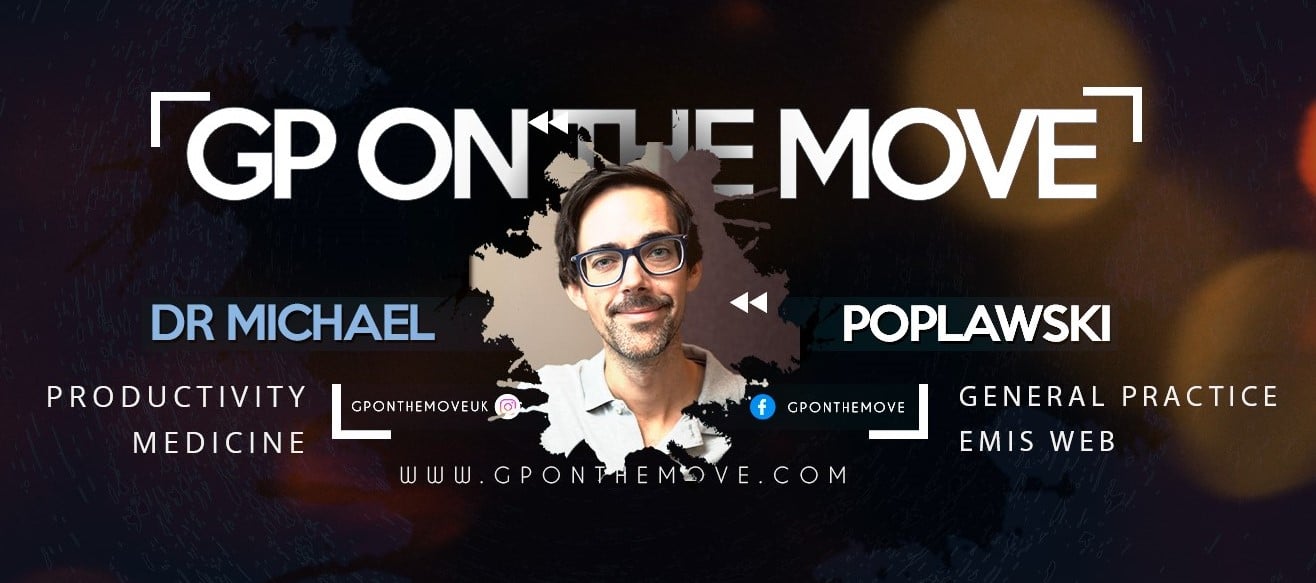Michael Poplawski is a GP, University Tutor, YouTuber, and Sound Engineer. He is on twitter: @GponthemoveUk and his YouTube Channel is http://www.youtube.com/c/gponthemove
How do you start a medical YouTube channel?
1. What?
So, you want to start a YouTube channel, or Instagram account, or maybe even a dreaded dance crazy tik-tok account, but you just don’t know what to post about? And in your extensive pre-starting research you have just realised that your breakthrough idea of posting photos of cute little kitties with funny captions has been done to death already?
You are not alone. Coming up with a good channel idea is one of the first and sometimes most difficult hurdles you will need to overcome in your journey to YouTube fame. The key here is to look within yourself – what makes you unique, what sets you apart from everyone else. Let me help you out here.
Firstly, you are a medic, or have some kind of interest in health or medicine. And that can really help narrow things down for you. Secondly, if you are a bit more advanced in your career, you might already have a specialty or a special interest. Maybe you’re an ear nose and throat doctor? Or you’re into lifestyle medicine? Skin? Cardiology? Respiratory? Gynaecology? The knowledge you have acquired over the years can easily translate into watchable material. But before you start describing the effect of premature ovarian insufficiency on the excretion of follicle stimulating hormone by the pituitary gland – you need to make one crucial decision.
Is your channel patient-facing or doctor-facing?
You have to understand that there is a massive difference between the two and realise that they both come with their own inherent advantages and disadvantages:
Is your channel patient-facing or doctor-facing?
1. Reach – there are approximately 9.2.million doctors in the world. And, I hate to break it to you, but it’s possible that not everyone will subscribe to your channel – so your reach will naturally be more limited by having a doctor-facing channel. On the other hand, there are 7.9 billion people in the world, of which 4.66 billion are thought to have access to the internet – and out of those – it’s quite likely that most of them will require or want to access medical advice at some point in their lives, so by going patient-facing your reach will be much wider.
2. Comments – before I started my medical YouTube channel, I found 10 other doctors in the YouTube sphere and started watching and analyzing their channels and their most popular videos. A recurring theme became quite evident. Those that were patient-facing, and especially those that decided to take part in spreading medical information about that whole COVID thing, were getting hundreds of thousands of views and comments. Sadly though, a lot of the comments struck me as being either completely irrelevant or sometimes even quite nasty. I mean especially with a topic as controversial as COVID, if you do decide to give medical advice or express your opinion, be prepared to have to defend you position, which may be something that will wear you out in the end.
3. Competition. There are lot of really good YouTube channels that are run by doctors that are patient-facing. That is because they recognize the reach potential with a channel like this. But I haven’t really seen too many channels that were purely doctor or other healthcare professional focused ones. Something that you should consider is deciding on a niche, which in my opinion, is a good idea especially at the start of your journey, because it will give you focus from the start, even if the drawback is less views initially. If I think of my personal favourite medical you-tuber in the world, Ali Abdaal, he started off being focused on medical stuff, but then became mainstream when he started reviewing apple products that could help students in their medical school journey, which also appealed to non-medics.
Right, you’ve decided on your channel’s profile, let’s talk content. As a medic, you will by and large fit into the education or entertaining education category, so start off with talking about things that interest you and that you are passionate about, and, even better, if you can show people how to solve problems that you have encountered in your role as a medic. Scratching an itch, which refers to this exact concept, will not only make your followers really grateful but also help all medics as a whole, which will in turn help us to provide better patient care – so in my opinion that’s a win-win. Having a YouTube channel is literally all about making mistakes. And I’m saying this as someone who did a 3-year degree in sound engineering after med school and also someone who loves tech and also loves being overprepared. You will always notice something slightly off after you publish your videos and just need to learn to live with it. And if you are wondering how much times you will need to live with your mistakes – the answer is 35. Just accept that your first 35 videos will be awful. Don’t stress about not going viral. You can have a really fun and successful YouTube experience with even with 10 engaging followers.
2. How?
This will all depends on how tech-y you are. There are medical youtubers out there who are in the hundreds of thousands of subscribers relying only on footage from their iPhone. What I’m going to say here may sound slightly strange and uncomfortably personal, but I feel visuals do play a role here. What I mean by that, is, if you are super hot, and you will probably know if you are super hot or not, just grab your phone in your hand and go for it. But for all us normal people out there, well, you will need 2 extra things. One is a way to stabilize your camera, so a tripod either for you phone or your DSLR camera and the second is some source of lighting to light up your face. A good idea is to just pop yourself in front of a window, allowing daylight to naturally brighten up your face. Otherwise, you probably won’t go wrong with one of those ring lights that may even be attached to your tripod. No one is going to want to watch a video with your face hidden in the shadows, regardless of how amazing your content may be. Constant shaking will also get quite distracting, so with those two simple things sorted, you will already be at a good starting point.
When you are ready to one up with production value – add in an external microphone of some description. Obviously, I’m a sound guy, so I could probably go on about this for hours, but a lot of people either use a lav mic – which are the clippy black ones you see TV presenters wearing – and the one in the description is a good, cheap option that will plug in directly into your microphone input and should be better that your built-in mic. But if you want more, look at this.
Hopefully that’s the tech bit sorted, now let’s talk quickly about your Shakespearean delivery. If you are a natural speaker, just write up some bullet points with what you will be talking about and go for it. But again, for all of us normal people out there – you may want to actually write up a word-by-word script. For any of you guys out there that have needed to video record yourself consulting with patients, you will very quickly notice, that as you are thinking about what to say, you may have some nervous tics you are not aware of, do a lot of ums, ahh, or in my case, “..Right…” Which, unless you are a pro at video editing will start to get really tiring for the people watching your videos. As you get good at doing videos with scripts, there is no reason why you can’t transition into just going for it with bullet points.
3. Why?
Now that we have covered the what? and the how?, shall we quickly talk about the why? Why do you want to start a YouTube video and, more importantly, is it ok to say money? And the answer to that is Yes! Not that you needed my permission of course. I started my YouTube channel because I thought it would make me rich. Not just rich rich, but like flying business class everywhere rich – something that sadly, my career as an NHS doctor will simply not allow me to do. Don’t get me wrong, doctors make good money and I’m not complaining here, although I’m getting the sense that it is starting to sound a bit like complaining, but, if money is your main driver, let’s find out if starting a YouTube channel is worth it money wise.
First, establish what your hourly rate is as a doctor and that will depend on your grade – and to see how much you will be earning throughout your career as a doctor in the UK, click on the link on the screen now. I’m a GP, so hourly locum rates for GPs are really good, think £80, £90, or even £100 an hour pretax, national insurance and pension contributions.
Now, how long does it take me to make a 3-4 mins YouTube video? Let’s see…
Now, how long does it take me to make a 3-4 mins YouTube video? Let’s see – research, writing the script, setting up my gear, doing at least 2 if not 3 takes to choose from, cleaning up the a-roll, recording and incorporating b-roll, extra editing, colour grading, mixing, mastering, final export, revision, export again, YouTube thumbnail, keyword exploring, adding descriptions and then sharing on social media sites… ten hours…
Hmmm, just checking, are you sure you still want to make videos?
So yeah, let’s be clear, I just gave up £64,800 to do bad Dad jokes whilst talking about EMIS over the last 18 months. Was it worth it? Well, I guess we would have to ask my dependents about that…
4. When?
This before last bit refers to something I already touched on and that is consistency. To quote Ali Abdaal again, he says to key to his success is quantity over quality. Churn out as many videos as you can consistently, and, overtime, you will build a following and become successful. If you add in quality on top of that, that process will happen much faster of course. You will need to find a good balance here to avoid burning out and so a simple formula that I would recommend and that a lot of youtubers are talking about as well – is 1 video a week for 18 months.1 video a week gives you enough time to research ideas, write scripts, spend time on editing, and also watch back your videos and pick up on mistakes that you can fix in subsequent videos further down the line. Something that I actually did, was split things up into 10 video blocks with 4 week breaks to recover after each block. This approach just seemed much more manageable and sustainable for me, so definitely something to consider. But again, we are all different and I would certainly see engagement drop in those 4-week break periods, so that may or may not suit you.
5. Red Flags
Let’s wrap this up with red flags, so things to avoid when starting a medical YouTube channel and, again, this is simply a guide, there are no hard and fast rules and so do whatever you want really, but hopefully some of these might resonate with you.
1. Video length. In my opinion, especially when you are starting out, the shorter the better. A pop song length YouTube video is perfect, because we all have shorter and shorter attention spans, but also less and less time to really invest in watching something without even knowing if we will get any value from it in the end. So keep videos and short and sweet and…
2. To the point. Get straight into it, avoid really long introductions and introducing yourself with all of your various degrees, placements you’ve done, audits and quality improvement projects, extra courses and so on. I remember clicking on a RCGP video and realizing that the actual content, the value to the viewer, only started after 10 mins of introductions from the experts at which point I clicked away probably in spite. If you want to introduce yourself, do it quick, “For those of you that don’t know me, I’m Mike, a GP working in Manchester UK”.
3. Avoid doing it completely on your own. Reach out to other medics that are also dabbling in social media, maybe even hire someone to help you and work as a sounding board for ideas. This will stop you from getting lonely and keep you energized and driven on this long journey. And if you are feeling lost and lonely – get in touch, maybe we can help each other out too!
That’s it guys, I hope that was informative. Feel free to contact me, leave a comment, send me an email, or grab your phone right now and just start recording! And if you’d like to see a YouTube video about all this click here.
Featured image by Michael Poplawski







Thanks for the advice. Definitely sounds we need to enjoy the process if someone was to start a channel.
This article is a fantastic resource for anyone interested in sharing their medical expertise with the world through video content. The step-by-step guide, along with the practical tips and strategies provided, make it easy to understand the process of creating a successful medical YouTube channel. The author’s emphasis on authenticity, engagement, and collaboration is especially valuable, as it highlights the importance of connecting with viewers and building a community around your content.
Thanks. I’m going to start my own channel!